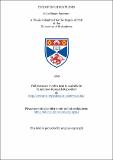Cyclopentadienylides
Abstract
Cyclopontadienylides (e.g, (III)) were prepared from dibromocyclopentene (l) b the action of cyclic organic bases followed by treatment with caustic alkali. The intermediate was shown to be the dibromide of the diquaternary salt (e.g. (II)), and the reaction scheme may be represented, in the case of pyridine, by the equations: (See full file abstract for equation) These ylides are brown-red crystalline solids, which impart strong colours to their solutions. The colour varied with polarity of the solvent, e.g. from orange-red in alcohol to a slightly purplish-red in benzene. The reactions of various organic bases with dibromocyclopentene were investigated but satisfactory products were obtained only from pyridine and substituted pyridines. However, rod materials of uncertain composition were obtained from aniline and ammonia. Also a compound from dimethyl sulphide was obtained, probably having the structure (IV) although satisfactory analysis results were not obtained in this case. (See full file Abstract for equation) The structure of the ylide from pyridine was established by catalytic hydrogenation to N-cyclopontylpiperidine and comparison of derivatives obtained therefrom with those from an authentic sample. Tetraphenylcyclopentaoienylides were prepared from 1-brom-2:3:5-tetraphenylcyclopentadiene by allowing this bromo compound to stand with the bases at room temperature, and removing the elements of hydrogen bromide with sodium hydroxide. Ylides formed in this way were blue to blueish- purple crystalline solids, showing a corresponding range of colour in organic solvents. The unphenylated ylides decomposed fairly rapidly on exposure to the air in the solid state, but more slowly in solution. The phenylated derivatives were quite stable as solids, but the colour of their solution faded quickly, Stability was enhanced in each case by storing the samples under nitrogen or in vacuo. Derivatives were generally difficult to isolate, but compounds were obtained with picric acid (from phenylated ylides) and benzene diazonium chloride (from unphenylated ylides, including that from dimethyl sulphide), a preliminary investigation was also made into the possibility of preparing many membered carbon rings by pinacone reduction of a-w-diketones. a-w-heptadecane dicarboxyclic acid was prepared as an intermediate.
Type
Thesis, PhD Doctor of Philosophy
Collections
Items in the St Andrews Research Repository are protected by copyright, with all rights reserved, unless otherwise indicated.

